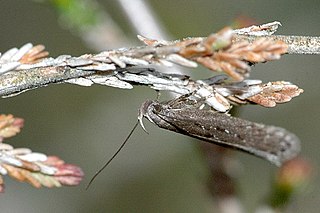
Neofaculta ericetella is a moth of the family Gelechiidae. It is found in Europe and Asia Minor.

Scrobipalpa acuminatella is a moth of the family Gelechiidae. It is found in most of Europe, as well as Turkey, southern Siberia, Central Asia and China (Anhui). It was recently reported from Canada, with records from Ontario and Québec.

Recurvaria leucatella is a moth of the family Gelechiidae. It is found in most of Europe, Turkey, Central Asia and the Caucasus.

The lobster-clawed moth is a moth of the family Gelechiidae. It is found in most of Europe, except for the Iberian Peninsula and most of the Balkan Peninsula. In the east, the range extends to Siberia and Taiwan.

Anarsia dryinopa is a moth of the family Gelechiidae. This species was first described by Oswald Bertram Lower in 1897. It is native to Australia and was introduced to New Zealand where it can be found in both the North and the South Islands.

Caryocolum fraternella is a moth of the family Gelechiidae. It is found in Ireland, Great Britain, Fennoscandia, Denmark, Germany, the Netherlands, France, Switzerland, Spain, Latvia, Estonia and Ukraine.

Caryocolum viscariella is a moth of the family Gelechiidae. It is found in Ireland, Great Britain, Fennoscandia, Denmark, Germany, France, Switzerland, Austria, Hungary, Italy, Estonia and Russia.

Scrobipalpa costella is a moth of the family Gelechiidae. It is found in western Europe.

Bryotropha senectella is a moth of the family Gelechiidae. It is found throughout Europe.
Anarsia citromitra is a moth of the family Gelechiidae. It was described by Edward Meyrick in 1921. It is found in Mozambique, Kenya, Malawi, Namibia, Mauritius, Réunion, South Africa and Zimbabwe.

Chionodes distinctella, the eastern groundling, is a moth of the family Gelechiidae. It is found in almost all of Europe, as well as most of Russia, Kazakhstan, Central Asia and North Africa. The habitat consists of dry, rocky heath and meadows and the verges and rough pastures.

Chionodes fumatella, the downland groundling, is a moth of the family Gelechiidae. It is found in almost all of Europe. Outside of Europe, it is found in Turkey, the Caucasus, Mongolia and from Siberia to the Russian Far East.

Metzneria metzneriella is a moth of the family Gelechiidae. It is widely distributed throughout Europe, as well as Turkey and southern Siberia. The habitat consists of dry pastures and calcareous soils.

Monochroa lutulentella, the black neb, is a moth of the family Gelechiidae. It is widely distributed in northern Europe and the central European mountains, east to the Ural Mountains. The habitat consists of fens, marshes and on river-banks.

Gelechia rhombella, the apple groundling, is a moth of the family Gelechiidae. It is found in Europe, the Caucasus, Transcaucasia, southern Siberia, the Russian Far East, Korea and China.

Scrobipalpa obsoletella, the summer groundling, is a moth of the family Gelechiidae. It is found in most of Europe, Turkey, the Caucasus, from Iran to Asian Russia (Transbaikal) and Mongolia. It has also been recorded from New Zealand, South Africa and North America, where it is probably an introduced species. The habitat consists of coastal salt marshes and sandy beaches.

Scrobipalpa samadensis, the buck's-horn groundling, is a moth of the family Gelechiidae. It is found in most of Europe and Russia.

Anarsia ephippias is a moth of the family Gelechiidae. It was described by Edward Meyrick in 1908. It is found in India and Sri Lanka.
Anarsia altercata is a moth in the family Gelechiidae. It was described by Edward Meyrick in 1918. It is found in India (Bengal).
Anarsia omoptila is a moth in the family Gelechiidae. It was described by Edward Meyrick in 1918. It is found in south India.
















